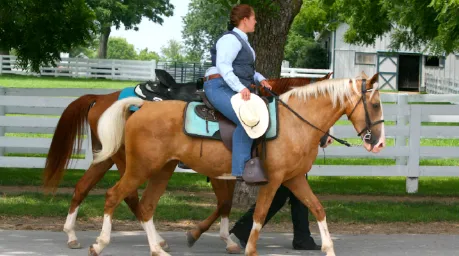Known for their striking appearance, smooth gait, and friendly disposition, Kentucky Saddle Horses have a loyal following and a rich heritage.
Originating in the early days of America, this versatile breed has evolved alongside its riders, known for an easy, comfortable ride whether on trails, in shows, or even parades. Here’s everything you need to know about this iconic breed.
History and Origins of the Kentucky Saddle Horse
The Kentucky Saddle Horse traces its roots back to the early settlers in Kentucky, who needed a strong, sure-footed horse capable of both work and pleasure riding. Early settlers bred local horses with imported Spanish, English, and Canadian stock, producing a versatile animal with stamina, strength, and the iconic “rack” gait. By the 1800s, the breed had become popular throughout the American South, where it was prized for both its utility and elegance.
Physical Characteristics of the Kentucky Saddle Horse
Typically, Kentucky Saddle Horses stand between 15 and 17 hands high, with a muscular yet refined build. Their long legs and balanced proportions allow for a graceful movement and smooth gait. They have deep chests and sloping shoulders, which contribute to their endurance and agility.
Coat Colours and Markings
The Kentucky Saddle Horse comes in various colours, including bay, chestnut, black, and grey, often with distinctive white markings on the face and legs. These markings add to their striking appearance, making them favourites in the show ring.
Unique Gaits of the Kentucky Saddle Horse
The Natural Gait
One of the hallmarks of this breed is its smooth gait. Kentucky Saddle Horses have an inherent four-beat gait, which allows for a steady, comfortable ride even over long distances. This gait is a source of comfort and ease for both the horse and rider.
The Distinctive “Rack”
The “rack” is a signature gait that sets the Kentucky Saddle Horse apart. This four-beat ambling gait is fast and smooth, enabling the horse to cover ground quickly without the bounce typical of other gaits. This makes the Kentucky Saddle Horse a popular choice for riders seeking a comfortable and elegant experience.
Temperament and Personality
Kentucky Saddle Horses are known for their gentle, willing nature, making them easy to handle and train. They are responsive, eager to please, and thrive on interaction with their handlers. Their calm temperament makes them well-suited for riders of various experience levels, whether beginners or seasoned equestrians.
The Kentucky Saddle Horse vs. the American Saddlebred
The Kentucky Saddle Horse and the American Saddlebred are often compared due to their shared ancestry and similar appearances. However, the Kentucky Saddle Horse is known for its natural gait and stockier build, making it distinct from the typically sleeker American Saddlebred. Additionally, while American Saddlebreds are known for high-stepping movement, the Kentucky Saddle Horse’s gait is smoother and more suited for long-distance riding.
Care Requirements for Kentucky Saddle Horses
Kentucky Saddle Horses require regular grooming, a balanced diet, and consistent exercise. Their coat may need extra care to maintain its shine, especially if they’re kept for shows. They also benefit from mental stimulation, such as varied training routines, due to their intelligent and curious nature.
Health Considerations Specific to the Breed
While Kentucky Saddle Horses are generally hardy, some are prone to specific issues such as joint health and metabolic conditions, which can impact gait and stamina. Regular vet check-ups, a tailored diet, and controlled exercise are important in maintaining their health, especially for horses involved in high-performance activities.
Choosing a Kentucky Saddle Horse
When choosing a Kentucky Saddle Horse, look for a balanced gait, sound conformation, and a calm temperament. Observing the horse’s natural gait and responsiveness to commands can offer insight into its suitability. Consulting a vet or experienced trainer can also help in identifying a well-suited Kentucky Saddle Horse for your needs.
Renowned Kentucky Saddle Horses in History
Over the years, several Kentucky Saddle Horses have gained fame for their beauty and performance. Horses like “Denmark,” known as the foundation stallion of American Saddlebreds, have left a legacy in breeding lines, helping to shape the breed we know today. These horses have become icons, celebrated for their elegance and lasting influence on equine heritage.
Associations and Registries for Kentucky Saddle Horses
Several associations, including the Kentucky Saddle Horse Association, help preserve the breed’s legacy, ensuring that breeding practices maintain the horse’s distinct qualities. Registries provide resources for breeders and enthusiasts, with events that showcase the versatility and beauty of this breed.
Conclusion
The Kentucky Saddle Horse is a blend of elegance, versatility, and rich American heritage. With their smooth gait, gentle temperament, and striking appearance, they’re ideal for both pleasure and performance riding. Whether you’re drawn to the show ring or leisurely trails, the Kentucky Saddle Horse offers a unique and enjoyable riding experience.
FAQs
1. What makes the Kentucky Saddle Horse different from other gaited breeds?
The Kentucky Saddle Horse is distinct for its natural racking gait, smooth ride, and versatile build, setting it apart from other gaited breeds like the Tennessee Walker and American Saddlebred.
2. Are Kentucky Saddle Horses suitable for beginners?
Yes, their calm nature and gentle disposition make them well-suited for riders of all experience levels, including beginners.
3. What is the average lifespan of a Kentucky Saddle Horse?
These horses typically live between 25 and 30 years, depending on their care and living conditions.
4. Can Kentucky Saddle Horses be used for competitive riding?
Absolutely. Kentucky Saddle Horses excel in competitive events, particularly in gaited classes, thanks to their natural racking ability.
5. How much exercise does a Kentucky Saddle Horse need?
They benefit from regular, moderate exercise to maintain fitness and flexibility, especially if they’re involved in high-performance activities like shows or competitive riding.
